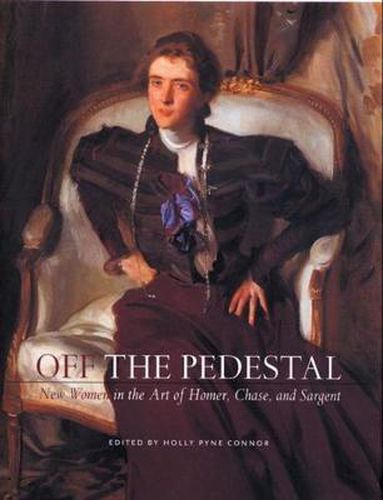Readings Newsletter
Become a Readings Member to make your shopping experience even easier.
Sign in or sign up for free!
You’re not far away from qualifying for FREE standard shipping within Australia
You’ve qualified for FREE standard shipping within Australia
The cart is loading…






Pictures of women portrayed as professional, athletic, and intellectual seem common to us today, but until the late nineteenth century, such representations of strong, self-reliant women were virtually, if not completely, absent from the visual arts and literature. Off the Pedestal is the first book to explore the radical change that occurred in the representation of women immediately after the Civil War. Three critical essays draw on the visual culture of the period to show how the collapse of slavery in the United States brought issues of subordination and autonomy to the surface for women in much the same way that it did for blacks. As women began attending college in greater numbers, entering professions previously dominated by men, and demanding greater personal freedom, these
new women
were featured more frequently in the visual arts and in a manner that made it clear that they had ambitions outside the domestic sphere. The complexity and pervasiveness of these women fascinated many of the most well known painters, illustrators, and writers of the time, including Winslow Homer, Mary Cassatt, John Singer Sargent, William Merritt Chase, Charles Dana Gibson, Henry James, Edith Wharton, and William Dean Howells. The women represented in works by these and other artists reflected those who, in life, were becoming liberated from the confines of the home and the sole company of their husbands and children. They were portrayed riding bicycles, hiking in the mountains, reading books and newspapers, and working as professionals. The depiction of female self-reliance, however, was not uniform throughout all visual media. Although painters and authors tended to portray these women positively, illustrators and photographers often vilified or satirized them. Among these negative stereotypes one could find the
manly
new woman-a contested figure whose appearance in journalism and elsewhere pointed to underlying social anxiety and demonstrated a widespread backlash against female empowerment. The medical community also condemned new women by arguing that females who studied or exercised vigorously would become sick, insane, or even sterile, thus threatening the welfare of the country. Featuring more than seventy color and black-and-white images, Off the Pedestal is an engaging and informative window into the ways that identities and attitudes are forged on the stage of visual culture. The book will accompany the traveling exhibition of the same name, which will open at the Newark Museum in the spring of 2006.
$9.00 standard shipping within Australia
FREE standard shipping within Australia for orders over $100.00
Express & International shipping calculated at checkout
Pictures of women portrayed as professional, athletic, and intellectual seem common to us today, but until the late nineteenth century, such representations of strong, self-reliant women were virtually, if not completely, absent from the visual arts and literature. Off the Pedestal is the first book to explore the radical change that occurred in the representation of women immediately after the Civil War. Three critical essays draw on the visual culture of the period to show how the collapse of slavery in the United States brought issues of subordination and autonomy to the surface for women in much the same way that it did for blacks. As women began attending college in greater numbers, entering professions previously dominated by men, and demanding greater personal freedom, these
new women
were featured more frequently in the visual arts and in a manner that made it clear that they had ambitions outside the domestic sphere. The complexity and pervasiveness of these women fascinated many of the most well known painters, illustrators, and writers of the time, including Winslow Homer, Mary Cassatt, John Singer Sargent, William Merritt Chase, Charles Dana Gibson, Henry James, Edith Wharton, and William Dean Howells. The women represented in works by these and other artists reflected those who, in life, were becoming liberated from the confines of the home and the sole company of their husbands and children. They were portrayed riding bicycles, hiking in the mountains, reading books and newspapers, and working as professionals. The depiction of female self-reliance, however, was not uniform throughout all visual media. Although painters and authors tended to portray these women positively, illustrators and photographers often vilified or satirized them. Among these negative stereotypes one could find the
manly
new woman-a contested figure whose appearance in journalism and elsewhere pointed to underlying social anxiety and demonstrated a widespread backlash against female empowerment. The medical community also condemned new women by arguing that females who studied or exercised vigorously would become sick, insane, or even sterile, thus threatening the welfare of the country. Featuring more than seventy color and black-and-white images, Off the Pedestal is an engaging and informative window into the ways that identities and attitudes are forged on the stage of visual culture. The book will accompany the traveling exhibition of the same name, which will open at the Newark Museum in the spring of 2006.